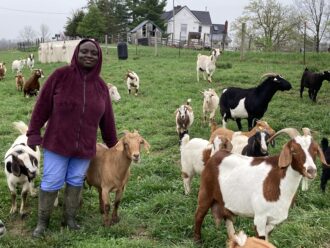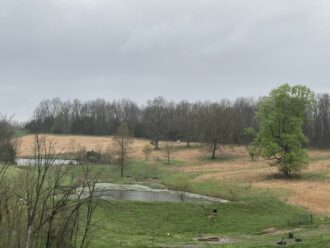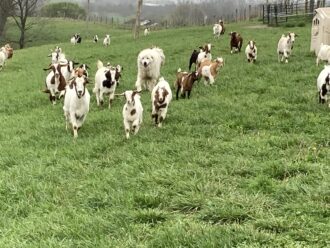SALVISA, Kentucky – Fatima Jackson is keeping her fingers crossed that native warm-season perennials being planted on her farm will perform better than tall fescue as an alternative forage for meat goats in the summer months.

“Come the heat of the summer in July and August, the goats won’t touch the tall fescue,” said Jackson. “They’ll eat it only as a last resort.” Tall fescue grows throughout the pastures at Action Jackson Farms, located south of Lexington. But the grass, known for ease of establishment, attractive yields, and good nutrition, contains an endophyte that is toxic to livestock in the summer months. Jackson and her husband, Justin, received a Southern Sustainable Agriculture Research and Education (SSARE) Producer Grant to test warm-season native perennials to replace tall fescue for summer grazing.
It's a cool, rainy day on the farm in April and Jackson is observing the one-acre plots that have been made ready for the trials. She’s hopeful that the varieties chosen will perform well enough to not only replace the fescue, but to also bring the goats to market weight faster.
“The market demand around here is always higher than the local supply,” said Jackson. “My husband and I are hoping that the forage will not only help us get the goats to market quicker, but will also help us expand our herd.” Currently the herd size is 150 with kids and they are hoping to expand to 160-200 does. The farm size is 80 acres, 15 acres that are not being used.

This spring Jackson will be planting and comparing switchgrass, big blue stem, and sericea lespedeza. Jackson knows that the sericea lespedeza performs well on the farm – it grows wild and she has trouble keeping the goats out of it.
“They love it,” said Jackson, “but the seed is so expensive. I hope that the other grass varieties do well in terms of palatability and market weight.”
The plan is to establish these grasses in separate fields and graze each field in the summer by subdividing the fields into smaller lots for rotational grazing. A control group of goats will be divided into four groups with at least 10 to 20 head per group to graze each field. Their weights will be recorded before the first rotation in each field and at the end of the last rotation of each field.
The first analysis of the trial will be performed later this year.
Fatima Jackson and her husband Justin moved to the farm in 2016. Originally in beef cattle production, the couple switched to meat goats due to familiarity with the livestock and market demand. They sell most of their livestock directly to processors in Indiana.
